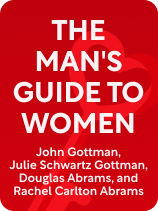

This article is an excerpt from the Shortform book guide to "The Man's Guide to Women" by John Gottman, Julie Schwartz Gottman, Douglas Abrams, and Rachel Carlton Abrams. Shortform has the world's best summaries and analyses of books you should be reading.
Like this article? Sign up for a free trial here.
How do you know when to commit in a relationship? What should you look for?
The right time to commit in a relationship is after the honeymoon period has passed and after you know that you are comfortable with someone and feel like the best version of yourself around them. You should also take notice of how you feel around your potential partner’s family.
Read the following for advice on when to make a commitment.
How to Know When to Commit
Many people want to be in a committed relationship. Research supports the benefits of commitment, with studies showing that men in committed relationships are happier, healthier, earn more money, and live longer. But how do you know when to commit in a relationship?
(Shortform note: While studies suggest that married men are happier and live longer, the same can’t be said of women. According to Paul Dolan, a professor of behavioral science at the London School of Economics, women who are unmarried and childless are the happiest subgroup in the population. Dolan explains that this subset of women often enjoy increased autonomy, facing less pressure to conform to the traditional and often stressful roles of wife and mother. Without the added responsibilities of marriage and children, they are also freer to nurture their social connections, careers, and personal interests. As a result, these women often experience lower levels of stress and greater overall life satisfaction.)
Men typically go through three stages in a relationship before knowing they want to commit. The first stage, limerence, is characterized by intense infatuation. Experts caution against making rash commitment decisions during this phase as the lust you feel isn’t necessarily indicative of lasting love. The second stage, often lasting the first couple of years of a relationship, is when conflicts arise and trust is built (or broken). In the third stage, commitment is solidified, with both partners willing to practice monogamy and mutual sacrifice. This stage is about continuing to deepen the relationship and grow together.
(Shortform note: The authors detail the conventional trajectory of relationships, from the initial attraction to committed monogamy. However, the relational landscape is expanding as increasing numbers of people explore less traditional partnerships, such as polyamory and open relationships. In the “bible of non-monogamy,” The Ethical Slut (1997), Dossie Easton and Janet Hardy advocate for these alternative relationship models, highlighting the importance of open communication and honesty over exclusivity in a partnership. Easton and Hardy discuss the common issues of jealousy and a sense of ownership found in both monogamous and non-monogamous dynamics and provide practical guidelines for engaging in what they call ethical non-monogamy.)
Here are several key questions to help you determine if you’re ready to commit: 1) Do you feel comfortable and relaxed around her?; 2) Does she make you feel confident, attractive, and loved?; and 3) Do you like who you are around her? Shared interests are less important than what it feels like to be together, but similar ways of expressing and receiving emotion, particularly affection, can be helpful.
(Shortform note: In The Defining Decade, Meg Jay recommends considering not only how a potential partner makes you feel but also how you feel around their family. Jay argues that the decision to commit to a partner shouldn’t be based exclusively on their family, but if there’s a lack of comfort with your prospective in-laws, it’s important to examine your choice closely. Discomfort with a partner’s family may reflect more profound value differences that have the potential to affect long-term contentment and compatibility in the relationship.)

———End of Preview———
Like what you just read? Read the rest of the world's best book summary and analysis of John Gottman, Julie Schwartz Gottman, Douglas Abrams, and Rachel Carlton Abrams's "The Man's Guide to Women" at Shortform.
Here's what you'll find in our full The Man's Guide to Women summary:
- A practical guide to navigating the complexities of female psychology
- How to initiate, build, and sustain a successful and mutually fulfilling relationship
- Why you shouldn't stop dating, even after you're married






